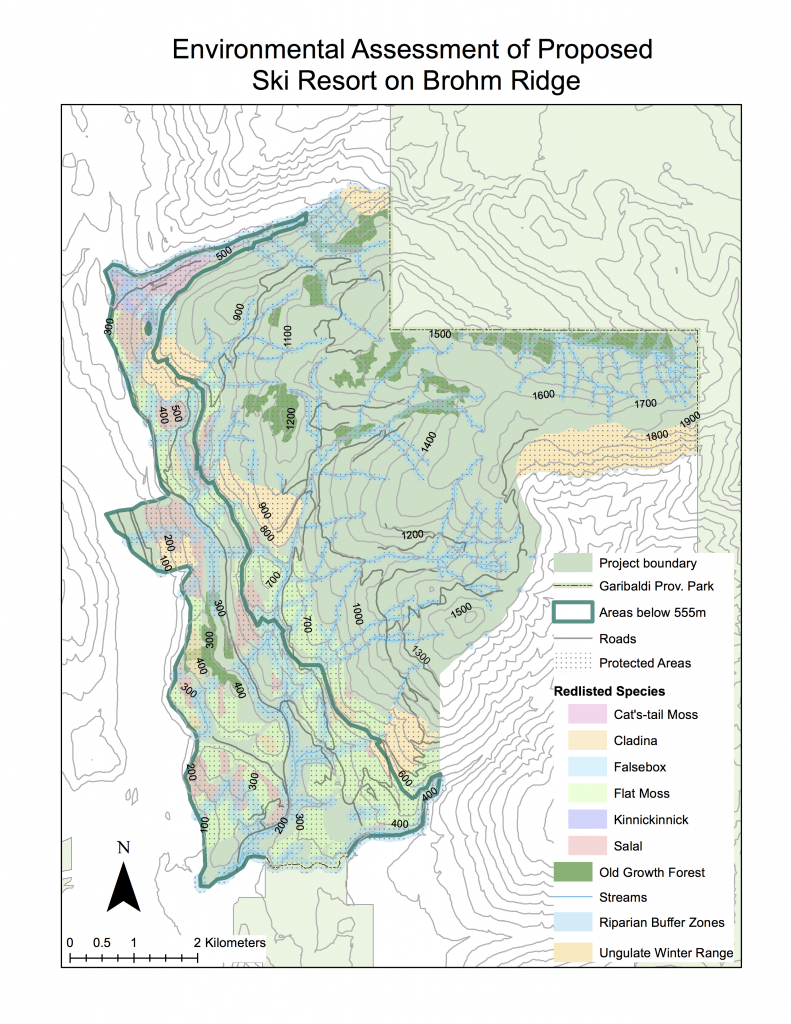I am a natural resource planner retained by the British Columbia Snowmobile Federation (BCSF) to evaluate their opposition to the Garibaldi at Squamish Project, a proposed year-round destination mountain resort on Brohm ridge, between Squamish and Whistler. The project has been through a long consultation process (since 1997), and has drawn criticism from the Resort Municipality of Whistler, as well as the BCSF. I will conduct an assessment of the potential environmental impacts in order to evaluate whether the continued opposition of BCSF to the project is supported with evidence, or whether the environmental impacts can, in fact, be mitigated and BCSF can withdraw their opposition.
The most obvious feasibility criterion for a ski resort is the presence of snow. It has been proposed that, in this area, there is no significant snowfall accumulation below 555m. So using a digital elevation model, I first reclassified what areas within the proposed project boundary were below 555m, finding that a total of 29.9% of the proposed area is below that elevation.
The second consideration for feasibility was land use, specifically, protected areas. In this study, I calculated the percentage of area the proposed area that is occupied by designated old growth management areas (6.8%) and over-winter ungulate habitat (7.9%.)
Additionally, I wanted to investigate what red-listed (i.e. endangered or threatened) vegetation could be found within the proposed boundary, and how much area would be occupied by the riparian buffer zones necessary around all streams.
Using Environmental Resource Management Ltd.’s assessment of terrestrial ecosystems, I isolated the red-listed ecosystems based on site series (soil conditions) and biogeoclimatic unit, finding 6 threatened species, which occupy 24.2% of the total proposed area.
To identify riparian and stream areas, I had to create a variable width buffer. Streams above 555m elevation require a 50m buffer, while streams below 555m require a 100m buffer, because higher elevation streams are considered to be less likely to be fish bearing. These combined stream and riparian areas occupy 30.1% of the total proposed area.
In order to determine what percentage of the total proposed area is protected without any overlap, I combined each of the four aforementioned map layers, old growth forest, ungulate winter habitat, red-listed species, and riparian and stream areas, and I calculated the total area. I found that 55.5% of the total proposed area is designated protected. Without removing any overlapping areas, the total percentage of proposed area that is protected is 69.1%, so 13.6% of the protected land is protected under two designations.
Further, I found that 29.9% of the area is below 555m, or outside of a significant snow accumulation area (although much of this does overlap with the protected area.) It seems that in order for this project to go ahead, there will be compromise, either of protected areas, or with respect to project development, both.
My main concerns regarding the environmental impacts of this proposed project are fish habitat and red-listed ecosystems. Presuming that, due to lack of snowfall, skiing is limited to areas over 555m, it would seem logical that resort and commercial development would take place at those lower elevations within the park boundary. These areas are dominated by red-listed species, and the streams in these lower elevations are also considered more likely to be fish bearing. Generally speaking, the preservation of wide swaths of vegetation and riparian zones is in direct opposition to commercial development. I do not see great potential for mitigation of these concerns, unless the developers were willing to market on the basis of preservation and environmental conscientiousness, in which case, development particularly of resort and commercial use areas would have to be greatly limited, and it may not be economically viable for the developers.
I do not think the project should continue. Personally, I believe that with over 50% of the proposed area already designated as protected, there is no reasonable argument for going ahead with the project. Additionally, as someone who takes advantage of the myriad recreational opportunities already present in the area, I would hate to see it become similar to Whistler, which is just not the experience I look for when heading outdoors. This doesn’t differ from what I wrote in the memo, but it is possible that my bias was influencing my write-up, but (luckily) I think the environmental evidence does support my argument.
